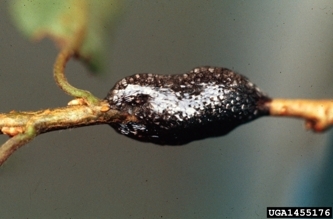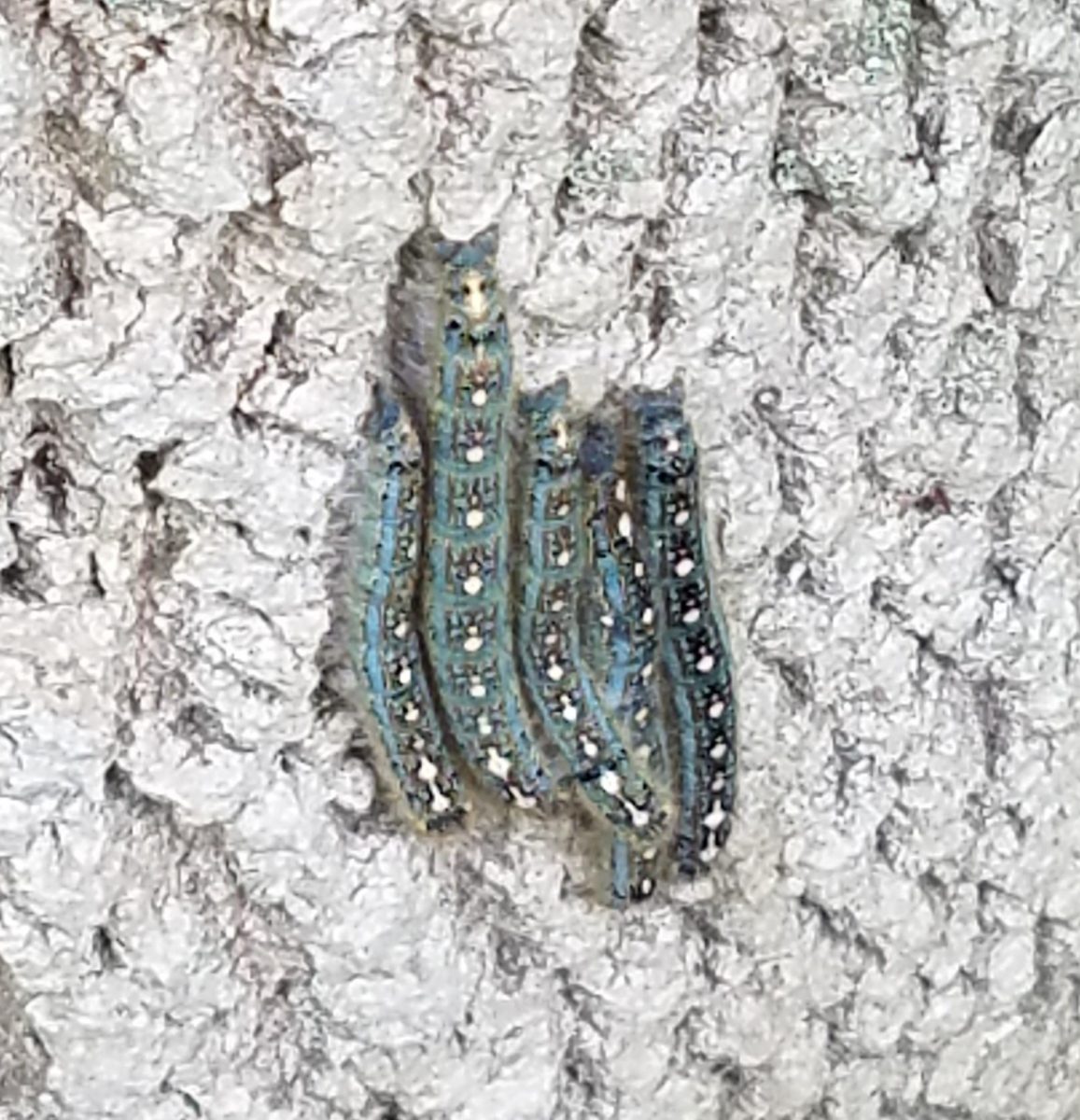
Image by Jack Loughrey
The eastern tent caterpillar, Malacosoma americanum, is a pest native to North America that can cause serious defoliation to deciduous trees in the family Rosaceae, in particular to Cherry (Prunus) and Apple (Malus).It is often mistaken for the Gypsy moth caterpillar as they emerge at similar times in the spring, and the fall webworm (which appears in late summer and fall). Eastern tent caterpillars can defoliate a tree but trees will usually recover from one or two years of damage. Successive years of high populations can cause stunted growth for host plants and may make them susceptible to disease.
Life Cycle
The adult moth will lay 150-300 eggs that will overwinter in shiny, varnished-looking, black masses encircling a branch or limb. Eastern tent caterpillar egg masses do not encompass foliage as the fall webworm masses do. The egg masses are easily spotted especially during the winter months when trees are bare of foliage.

Eastern Tent Caterpillar egg mass. Whitney Cranshaw, Colorado State University, Bugwood.org
It is in March when the eggs hatch that their presence is easily seen. As the young hatch they spin their silken tent in the crotch of a branch. The newly emerged caterpillars will stay together, sometimes joining with the young from a nearby egg mass to form one large community.The caterpillars will emerge from their protective tent in the early morning, in the evening or even at night to feed. They will stay within their enclosure during the heat of the day, if it is raining or if it is too cold. Over the next 4-6 weeks they will feed on nearby foliage, increasing the size of the tent to accommodate their increasing size. The black caterpillar with a white stripe bordered by blue down its back will reach a length of 2 to 2 ½” at which point they will stop feeding and will leave the tent.
The larvae are frequently seen wandering across walkways, roads, buildings, and other plants as they look for protected places to spin a 1” long, whitish cocoon and pupate The reddish-brown adult moth will emerge 3 weeks later to mate and lay the eggs on small branches that will hatch the following spring. There is one generation per year and populations will fluctuate from year to year.
The Forest tent caterpillar, Malacosoma disstria, is a look-a-like to the Eastern tent caterpillar but it has white spots down the back instead of a stripe. It feeds on deciduous shade trees such as ash, aspen, birch, elm, oak, and sugar maple and flowering fruit trees such as cherry. It does not construct tents like other species in the Malacosoma genus, instead it will spin silken sheets where the larvae will congregate in groups. It will create a white cocoon in folds of leaves or another protected area in which to pupate, emerging 3 weeks later as the adult moth. It also has an overwintering egg mass similar to the Eastern tent moth. Control measures are similar to those below.

Image by Linda Spoerl
Hosts
The Eastern tent caterpillar favors members of the Rosaceae family as its host plants. This family includes the genus Prunus which encompasses almond, apricot, cherry, crabapple, peach, plum, and quince, the genus Cotoneaster which includes hawthorn and rowans, and the genus Sorbus which contains service tree and mountain-ash.
Control Measures
- Remove and destroy the shiny egg masses during the fall and winter.
- Newly formed tents in the spring can be removed by hand and destroyed.
- Larger tents may need to be pruned out or removed with a large stick before being destroyed.
- Do not use an open flame or torch to remove tents.
- The insecticide Bacillus thuringiensis var. Kurstaki, when applied to the foliage and ingested, is effective against young larvae.
- Insecticidal soap or Neem oil may also be used although they may cause foliar damage if applied in a hot, sunny day.
- Contact insecticides may also be used but are not effective while larvae are within the protection of the tent.
- Caterpillars may be parasitized by various braconid, ichneumonid, and chalcid wasps.
- They are also a food source for birds, toads, snakes, raccoons, and other insects.
- Disease can also control their population.
Despite good cultural practices, pests and diseases at times may appear. Chemical control should be used only after all other methods have failed. READ THE LABEL on each pesticide container before each use. Apply as directed. Heed all warnings and precautions. Store pesticides in their original labeled containers out of reach of children, irresponsible people and pets, preferable under lock and key. Dispose of empty containers safely.
For pesticide information or other questions please call toll free: 877-486-6271.
Revised by UConn Home and Garden Education Center 2016.
Issued in furtherance of Cooperative Extension work, Acts of May 8 and June 30, 1914, in cooperation with the U.S. Department of Agriculture, the Dean of the College, Cooperative Extension System, University of Connecticut, Storrs. The Connecticut Cooperative Extension System is an equal opportunity employer and program provider. To file a complaint of discrimination, write USDA, Director, Office of Civil Rights, Room 326-W, Whitten Building, Stop Code 9410, 1400 Independence Avenue, SW, Washington, DC 20250-9410 or call (202) 720-5964.